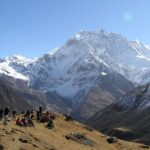Nepal has trekking peaks ranging from 5,500 to 6,500 meters, which provide a perfect entry-level option for exploring majestic Himalayan surroundings. There are plenty of popular trekking peaks including Island Peak and Mera Peak, all providing incredible photo opportunities, fantastic routes, and amazing mountain vistas.
The other common trekking peaks such as Island Peak and Mera Peak also provide their level of challenge and scenery. These options allow trekkers to select the trekking peak that will provide them with the best opportunity to fulfill their ambitions with their experiences.
An excellent option for novice climbers is the Langtang Region’s 5,700-meter Yala Peak. Climbing Yala Peak requires very little technical climbing skills, there is a scenic route that will get you there, and the climb is manageable making it a good choice for any novice trekking self-guided climber.
Selecting the right trek and climbing reference is important for safety or enjoyment. Your skill level, experience, fitness, and preferences should guide you in the decision-making process so that any adventure will be rewarding and enjoyable with as little risk as possible, such as altitude sickness or technical issues.
Overview of Yala Peak
Yala Peak, a trekking peak in Nepal’s Langtang region close to the Tibetan border, rises to 5,520 meters (18,110 ft.). It is classified as a trekking peak because of its non-technical climb and is suitable for beginners and intermediate picks trying to get high-altitude experience.
Yala Peak is best climbed in the spring and fall when the weather is favorable. It’s a great place for climbers depending on which way the weather pattern is going, the peak itself offers incredible panoramic views of other surrounding mountains such as Shishapangma, and Langtang Lirung. Climbers also get to visit many culturally rich Tibet-influenced villages along this trek and get to visit the Kyanjin Monastery.
Popular Alternative Trekking Peaks in Nepal
- Island Peak (Imja Tse)
The Imja Khola Valley in Nepal, which is a part of the Everest region, is where Island Peak is situated. This peak is generally regarded as a moderately difficult climb although it features some technical ice and rock sections, requiring mountaineering skills. Island Peak is a great option for climbers who have previously trekked to high altitudes and want to develop their technical skills.
Island peak climbing
The summit day of Island Peak is likely the most challenging of the whole trek, with multiple vertical ice walls and fixed ropes. The trekking route allows access to great views of Everest and the neighboring peaks. It is important to be aware of rapid altitude gain and acclimatization. Island Peak can be trekked in spring and autumn when there is a greater likelihood of stable and pleasant weather.
- Mera Peak
Mera Peak is the highest trekking peak in Nepal at 6476 meters, located in the Hinku Valley. The trek to Mera Peak is moderately difficult but much less technical than Island Peak and does allow adventurers to enjoy high-altitude trekking with little to no climbing knowledge.
From Mera Peak, trekkers will be treated to panoramic views of the Himalayas including Everest and Makalu. Long hiking days and consideration of altitude acclimatization are necessary for trekking and ascending Mera Peak. Because of the better weather, spring and fall are the best times of year to attempt ascending Mera Peak.
- Pisang Peak
The Annapurna region’s 6,091-meter Pisang Peak is a difficult climb that calls for considerable climbing skills. It consists of varying steep ice and rock ridge climbs, which would be best suited to climbers who have strong technical mountaineering skills.
Pisang Peak provides stunning views of the Annapurna massif and the other valleys surrounding the peak. This climb presents challenging terrain related to the conditions and the variability of the weather. The optimum seasons to climb Pisang Peak are spring and fall because of the safer and more stable conditions.
- Lobuche East
Another peak in the Everest region is Lobuche East, which stands at 6,119 meters. This summit is semi-technical and offers moderate to difficult climbing. Lobuche East incorporates some tough climbing on glaciers along with trekking and glacier transit. This peak would be best suited to climbers who want to progress beyond the trekking peak level to a more challenging climbing experience.
The climb offers spectacular views of Everest, Nuptse, and more giants. The summit push on Lobuche East is steep snow and ice slopes, requiring the use of crampons and ropes on summit day. The spring and autumn would be the preferred climbing seasons because of stable weather and lower incident rates.
Key Comparision Factors
- Difficulty & Technical Requirements
Yala Peak is a non-technical climb suitable for beginners with some fitness and enough acclimatization days. Island Peak and Lobuche East contain moderate technical sections which require mountaineering skills such as the use of an ice axe and a rope. Pisang Peak is more difficult and calls for more experienced rock and ice climbers with advanced climbing abilities.
- Accessibility & Trekking Duration
Yala Peak has a shorter trek and provides more accessible access from Kathmandu for trekkers with limited time. Mera Peak and Island Peak have longer approaches to the trek that require more days of trekking and acclimatization and are therefore better suited for advanced trekkers who have flexible time to spend on trekking.
- Scenery & Cultural Experience
The Langtang Valley which is home to the Yala Peak hike is a beautiful place with a rich Tibetan Buddhist culture. Island Peak and Lobuche East provide amazing views of the Everest region and include views of Everest, Nuptse, and Lhotse. Pisang Peak is located in the Annapurna region and provides a range of mountain scenery with a cultural experience.
- Permit Costs & Logistics
Permit costs vary considerably. Yala Peak and Mera Peak permits are comparatively easy to acquire following the low costs compared to Island Peak and Lobuche East which require climbing permits and other fees.
Guide and porters are also part of the expedition and are recommended for technical peaks like Island Peak, Lobuche East, and Pisang Peak are climbed to ensure safety.
Who Should Choose Yala Peak?
Yala Peak provides an ideal opportunity for first-time climbers who want an easy introduction to Himalayan mountaineering. Yala Peak is a non-technical climb and has a moderate altitude which allows first-time climbers to experience high-altitude climbing with only trekking skills and gradual acclimatization.
Climbing with a professional guide provides climbers with proper instruction, including displacement training, fly movement activities, and coping mechanisms as well as all the safety protocols to make sure the climber feels safe and confident through the climb.
At the same time, Yala Peak is also good for trekkers who want a shorter, less technical climb while experiencing a range of cultures. The route through the Langtang Valley offers incredible Tibetan-influenced villages and monasteries that elevate the experience past just a summit.
All of this makes Yala Peak an excellent choice for many adventurers simply for the low level of difficulty and prolonged engagement with local culture.
Who Should Consider Other Peaks?
Climbers with previous mountaineering experience should take into consideration Island Peak or Lobuche East. Both peaks do include some moderate sections of technical climbing including ice climbing, rock climbing, using crampons, ropes, and abseiling techniques.
Lobuche is more technical and requires advanced mountaineering training, experience, physical fitness, and comfort using technical climbing gear for their own safety in the alpine environment.
Those wanting an experience at high altitude may try Mera Peak which is the highest trekking peak in Nepal. Climbing Mera Peak involves some amount of altitude gain although it is relatively moderate technical climbing compared to Island Peak or Lobuche East. Mera Peak is for those wanting to test their endurance and acclimatization skills at a higher altitude going beyond the beginner peaks.
Technical climbers wanting a more difficult ascent may wish to pursue Pisang Peak located in the Annapurna region that does require an experience level of solid ice climbing and technical mountaineering skills. Therefore, it is best suited for climbers with experience climbing steep and technical terrain that require more complex techniques.
Conclusion
The decision to climb Yala Peak or other trekking peaks depends on your experience, fitness, and adventure goals. If you are a beginner or looking for a shorter climb, then Yala Peak is the one for you. If you are a more ambitious climber, wanting a variety of technical trips on different trekking peaks, you will be looking at Island Peak, Lobuche East, Mera, Pisang Peak, etc.
Ultimately it depends on balancing your ability with the type of experience wanted. Yala Peak will provide a soft introduction to climbing in the Himalayas, while Island Peak and Lobuche East require more technical approaches. If you consider everything, you will have a very safe, rewarding, and successful journey in line with your trekking dreams.
Keep an eye for more latest news & updates on Daily!



